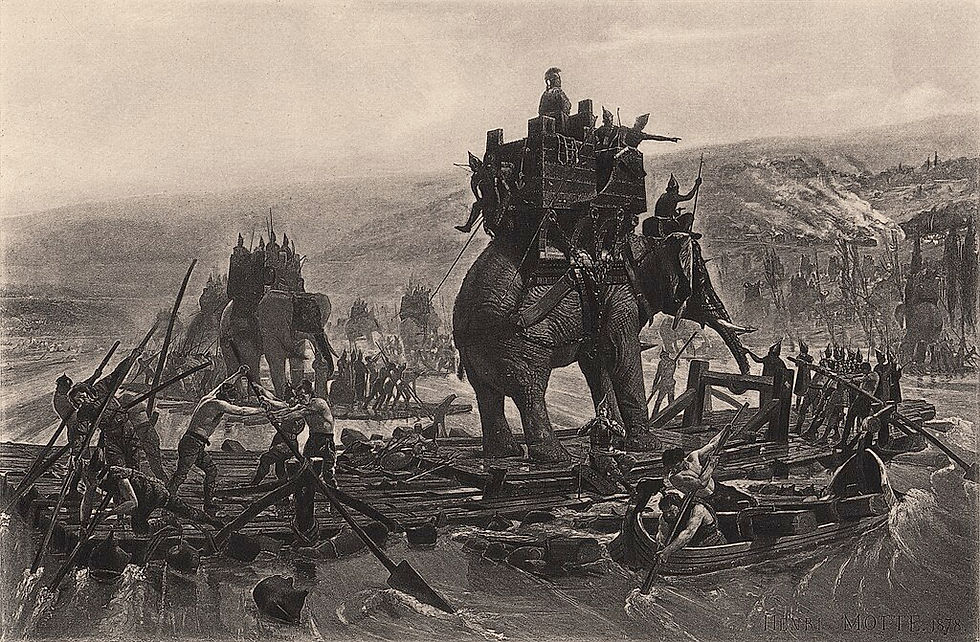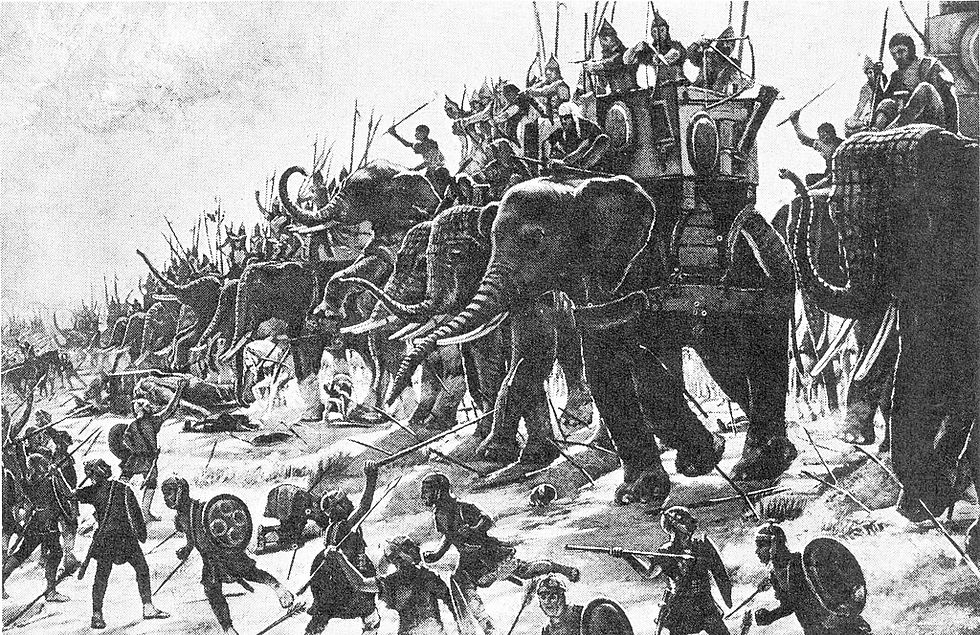Carthage Blog 8 - Battle Elephants
- Scot Stoddard
- Jun 30, 2025
- 8 min read
Updated: Jul 20, 2025

A brief history of Battle Elephants
Battle Elephants, or more commonly called War Elephants, are elephants that were trained and guided by humans to participate in combat. Their main combat role was to charge the enemy, break their ranks and instill fear and panic! Elephantry is the specific term for battle units who employed elephant-mounted troops; kind of like infantry, only with elephants.
The usage of elephants in battle dates back some 3,000 years, although nobody knows exactly when it started, but it is the common belief that it began in ancient India. Ancient China also used, to a limited degree, battle elephants, as did Persia, many Mediterranean civilizations, Hellenistic Greek states, the Roman Empire and, the subject of the album, Carthage. Elephants being used in battle continued on up until and through the Middle Ages, but usage declined upon the invention of firearms and other gunpowder-based munitions. While the history of battle elephants in India dates back to the 6th century BC or earlier, they used, of course, Indian Elephants. Carthage adopted some of the these same strategies, only using Northern African Elephants. So without a complete history of ancient India, let's move on to our subject, Carthage.
Carthaginian Battle Elephants
As you now know, if you've been reading these blogs all along, Carthage was located in Northern Africa, in what is now called Tunisia. So they used "local" North African Elephants, naturally, in their battles against the Roman Empire, or the Punic Wars. The word "Punic" comes from the Greeks, and you can read about it at that link, but it's really just the Greek word for the Carthaginians. Unfortunately, this species of elephant became extinct through this exact over-exploitation. The North African Elephant was generally smaller than Indian elephants, perhaps a little over eight feet tall at the shoulder, and had big ears and concave backs, typical of modern African elephants.
The Carthaginian elephants could not swim deep rivers and had to be transported across rivers by boat due to their smaller size. Some scholars also argue that the use of turrets on the backs of these smaller elephants was not widely employed, and that depictions of such are more an artistic rendering than actual based in fact. That's up for debate, apparently. For the purposes of my cover art, I have given the elephant the turret, since, hey, I'm an artist and can do artistic interpretation!
There is evidence, however, that Carthaginian elephants were furnished with turrets, such as the ones used by Hannibal in his famous alps crossing. So I went with that.

Carthage used battle elephants extensively in the First and Second Punic Wars, The effectiveness of elephants in battle, however, met mixed reviews, and results varied widely depending on the strategies employed. Proper tactics were needed to take advantage of the elephants' strength and cover their weaknesses. In the Battle of Adys in the First Punic War, 256 BC, elephants were ineffective due to the terrain. In the Battle of Panormus, the Romans were able to scare the elephants, causing them to scatter from being unsupported by infantry.
However, probably the most successful and famous use of war elephants by Carthaginians was done by Hannibal, the great Carthaginian general, in 218 BC at the Battle of Trebia during the Second Punic War, the very first battle in that war. Hannibal famously lead his troops of about 40,000 men and 38 elephants in a sneak attack by crossing over the Alps into Northern Italy. While many of the elephants did not survive this rigorous crossing due to the severe conditions, the remaining ones were quite effective in their use to break the ranks of the Roman legions, allowing the Carthaginians to stand fast and defeat the Romans. I can only imagine being a Roman legionnaire at the Battle of Trebia, seeing an elephant for the first time, and it's charging straight at you. Panic ensued, certainly. The Romans eventually figured out how to deal with this usage of elephants, however, and were able to defeat Hannibal at the Battle of Zama in 202 AD. These mentions of Hannibal are only cursory in this post, and we're going to get into him much more deeply in the blog for the track named after him, Track 10 - Hannibal.

So what about the music?
You might think, for a track titled "Battle Elephants", that the music would be really, really heavy. And I think I was going to go there, but decided not to. While there's a heavy section towards the end, representing a battle, most of the track is rather upbeat and on the lighter side.
The track opens with several overlapping samples: Two people speaking (in French, I couldn't get a sample of anybody speaking Phoenician), the sounds of birds and other animals in the wild, and then, of course, elephants stampeding! A synth then comes in with a brief introduction of what will be the main melody on in the opening movement or section. We have a chromatic ascending chord progression here, starting in B minor:
b-7, C+7, c#-7, D
Guitarists out there, or anybody who plays an instrument, try it; it's fun!
Then it goes to:
G, A, e-7, F#7
The melody continues on in both the synth part and is played in unison by the lead guitar. This is a convention I've used a lot in this track and the remaining tracks of the album, as well as some of the earlier tracks, in certain sections. Sometimes, and quite often, I will write a bass part first, then build a chord progression over that in whatever instrument; in this case, it's a pad synth. It could be a scratch guitar track, or piano, as well. Then I will write a melody over the top of that on whatever track: Again, a synth, piano, a violin, whatever; it's always different. But then you have your melody in place. I find it easier to actually write out melodies in MIDI notation than to come up with something on the fly sitting there with a guitar. In MIDI, you have the ability to change or edit pitches, the length of notes, the attack, the velocity, without having to do another "take" or starting over every time, like on a live guitar track. So in this case, I wrote the melody on the synth track. Then, later on, when it's time to play lead guitar, which is always last in the way I work, I simply read the MIDI notation on that synth track and play it on the guitar, often after a LOT of practice! Then I can decide to leave the synth playing in unison with the guitar, or I can mute or delete the synth track, by section. In this section, and in most of this song, I have more than one instrument playing the melody, and Cat, in mixing the track, does a wonderful job of mixing these two tracks together. What makes this even more interesting is writing in some pitch bends on the synth track and copying those on the guitar, which isn't always easy, but yields very cool results with the minor harmonic differentiations and textures! You will hear that a lot in this track!
And here I want to give special thanks to Cat Corelli for just that. I don't know if I've even mentioned yet in any of the blogs that Cat does all the mixing and mastering for all my music. I give her a heaping ton of credit for the work she does, and she's a helluva lot better at mixing than I am. We have a deal: I play bass on her songs, she mixes and does the mastering for me. We can cover more ground that way collectively, working together.
So we go through this section with two repeats of this chord chain, then there's a bridge. Which goes:
G, b-7, e-7, Bbdim7, b-7, C+7, e-7, F#7. Another interesting chain of chords! So while the key is minor, there's a lot of major chords and +7 chords throughout here that, along with the bouncy tempo and moving bass part, make this section sound bright and pretty happy.
Then we go back to the opening chord chain of this section, but the drums are doubled up and it's really moving now, only to drop us off into the half-time Section 2.
This section now at 1:40 is quieter, and there's again the melody on the pad synth, this time, and lead guitar, and it's kind of relaxed now, more pensive, thoughtful, and really pretty beautiful. The chord chain is more minor, I'm not going to write it all out here, We have clean/chorus rhythm guitars here strumming the pattern, and a flanger on the bass to give it a lot of bottom. It's elephants, ya know! The second synth is still doing the chords, it's just a different synth, lighter, with more air. This chord chain on this synth comes back in the beginning of the track Hannibal, symbolically, and in other sections of Hannibal, as well, for continuity of the related theme. I've added some electronic percussion to the standard drum kit here, as well, because I thought it helps with the atmosphere a bit, making it more like a hip-hop track or something EDM. Blending genres here, like always.
So there's a couple repeats of this initial chord chain, then a bridge, more of the initial chord chain, all with the main melody for this section over it all. Then there's a more free-form ad lib guitar solo here by itself, no synth, but the same chord chain. And that carries on for a couple passes.
Now we end up at the first heavy section of this track, at about 3:18 in. Here I've used my TC Electronic Dual Wreck pedal with a huge amount of distortion. This pedal is crazy, and it's got a lot of bite and high end in it, so I only use it sparingly when I want that exact sound, and I thought this section called for just that. So we go into this heavy riff for a bit, with a lead over the second and third pass. All to end up back where we started, at the beginning!
So here comes the opening chromatic riff from Section 1 once again, only this time it's more deliberate, half-time, with big slides on the guitars and a really plodding rhythm in the drums and bass to mimic elephants walking. You can almost feel the footsteps!
The second and third pass of this feature another lead guitar/lead synth melody with huge ascending slides in it to mimic elephants trumpeting after their triumphant win in battle.
At 4:44 we go back to a heated redelivery of the introduction section, again with that same lead synth/lead guitar melody driving it home with some intense.
Then at 4:58 we go into a really quiet, cool-down outro repeat of Section 2, with that same pad synth playing the melody, the flanger back on the bass, light, airy chords in the other synth, and we're out. The elephants charge off into the distance.
Summary
When doing my initial research on this album, in selecting the topics for tracks, I of course came upon the great General Hannibal. But upon learning of his use of elephants in battle, I thought it was worthy of its own track. I'm glad I did it, I really like this track. I hope you've enjoyed this breakdown of the music and the history behind the topic. Join me again next time for a discussion on Track 9, Seventh Sicilian War. It's going to be a fun one! Thanks for being here.












Comments